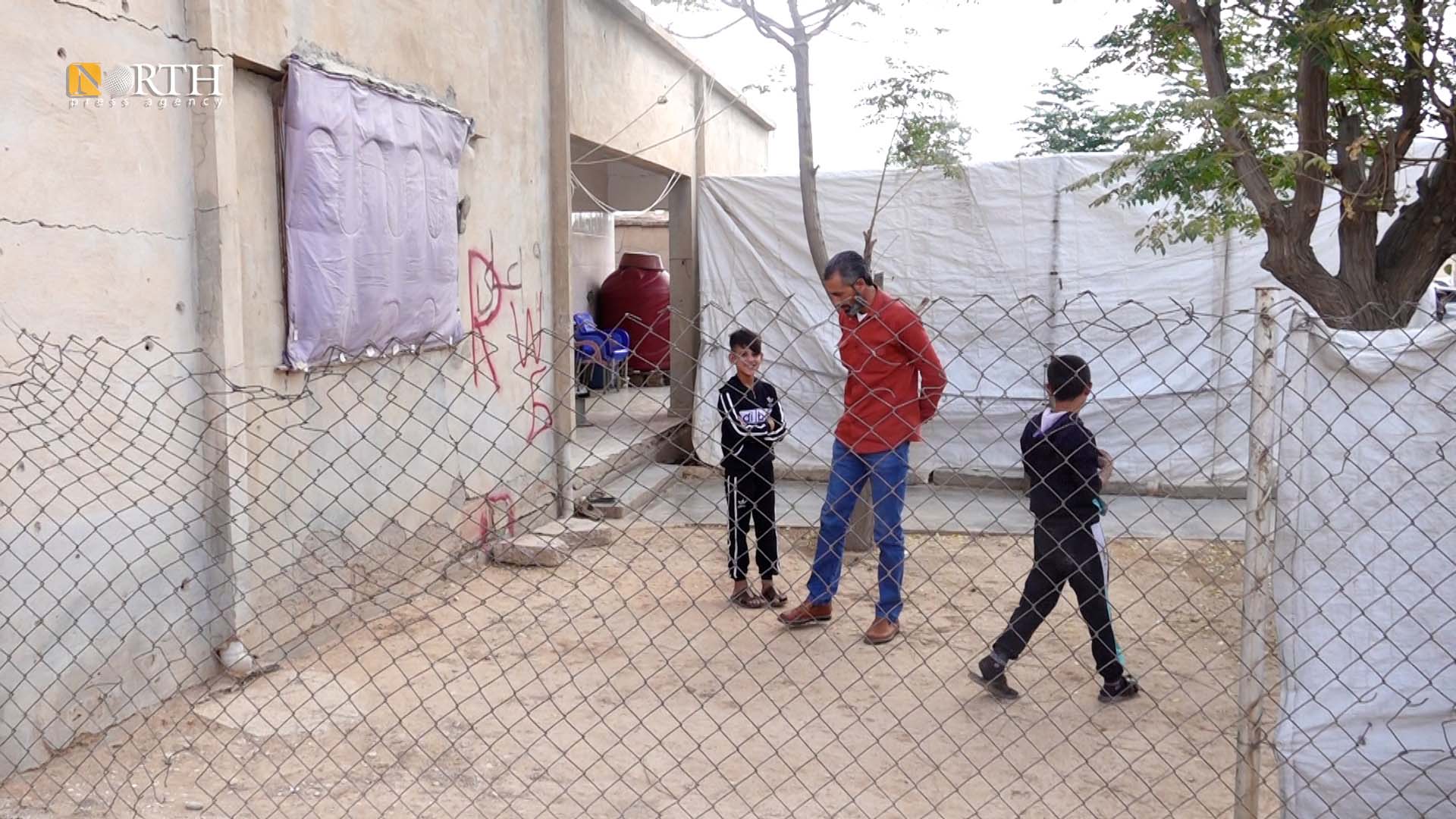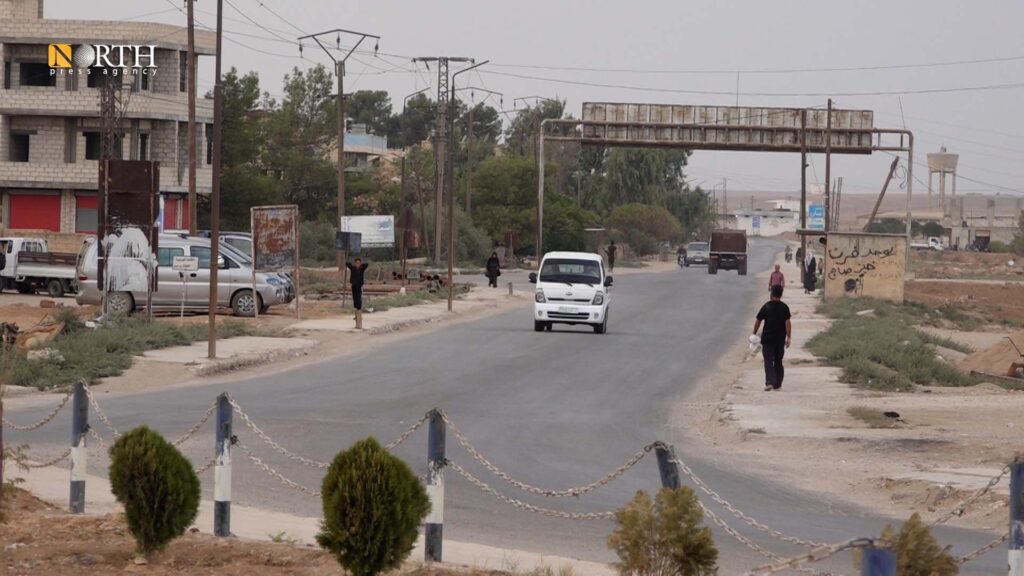IDP from Syria’s Sere Kaniye heartbroken by displacement
TEL TAMR, Syria (North Press) – At the main roundabout in the town of Tel Tamr in north of Hasakah, northeastern Syria, Ahmad looks heartbrokenly at the road leading to Sere Kaniye (Ras al-Ain), his hometown, as he is unable to return home.
After minutes of staring, Ahmad Bozan, 43, sits on a bench as banners of military councils affiliated with Syrian Democratic Forces (SDF) hoisted on iron poles round him flutter. This makes the situation even worse for Bozan reflecting his inability to go home.
Just like tens of thousands of people of Sere Kaniye, Bozan fled his home in the aftermath of the invasion by Turkish forces along with Syrian opposition factions, known as Syrian National Army (SNA), in October 2019.
Since then Bozan lives with a large number of IDP families in the village of Tel Nasri, south Tel Tamr.
After sitting on the bench for a while, Bozan rides his car to the utmost point where a civilian could reach on the road to his city, north Tel Tamr, while he is listening to a song by the Kurdish singer Roni Jan who himself hails from Sere Kaniye. The song reads in Kurdish “If you go to Sere Kaniye, send my greetings to the pretty [Sere Kaniye].”
Bozan turns back to the village of Tel Nasri. The road to Sere Kaniye is impassable; it is controlled by Turkish forces and SNA factions.

Unforgettable day
On a balcony, Bozan is replete with memories of that road which he used to pass on daily basis when he was working as a taxi driver.
On the advent of the third anniversary of the “occupation” of Sere Kaniye, Bozan recalls the last moments he spent before displacement in his village Ain al-Hissan in west Sere Kaniye in which he lived in for 40 years.
The man, who looks older than actually he is, dates back in memory to the first day of the attack, “We were at home when Turkish warplanes bombed a nearby village causing panic among villagers and leading to their displacement. We left too.”
“When I reached the city of Sere Kaniye, we were stuck on the streets in the congestion as everyone wanted to run for his life amid artillery and warplanes bombardment,” he said.
At sunset, Bozan was at Tel Tamr, around 35 km from the city of Sere Kaniye. He and his family spent the night in the car, while large numbers of people spent the night in the open, on the roads and in gas stations. “That has been the worst ever day of my life,” Bozan noted.
On the second day, Bozan headed to the city of Hasakah where he spent 10 days after which he returned with his family to Tel Tamr to settle in the village of Tel Nasri, the last destination in his displacement journey up to now.
No return
Sere Kaniye IDPs reject to return to their homes which are under the control of Turkish forces and SNA factions. They fear return amid growing human rights violations against civilians, according to human rights reports.
Since the invasion of Sere Kaniye and Tel Abyad in October 9, 2019, Synergy Association, a non-governmental non-profit organization whose staff is mainly activists from Sere Kaniye, documented 56 murders, 72 bombings, 511 arrests and 185 enforced disappearances.
The association documented 325 cases of torture, of which five persons lost their lives, 92 detainees were transferred to Turkey, 48 of them received sentences ranges between 13 years to life imprisonment.
Synergy stressed that what is taking place in Sere Kaniye and Tel Abyad by Turkish forces and the SNA factions are “much higher than the documented cases,” and that violations are taking place in a wider scale compared to documented cases.
After he was displaced, he received information from people in his first village that his home was set on fire by the SNA factions after it was plundered. A number of homes owned by his relatives were blown up, and olive trees were cut down.
On the possibility of his return to his village, Bozan says, “We cannot return to our village or city; the mercenaries issued a directive against us. Anyone returns to the village of Ain Hissan is punished.”
“There is no safety frankly, each faction has a different approach,” he says.

Displacement is difficult
Bozan, who works as a driver functions as a head of a commune located at his neighborhood in Tel Nasri, says “displacement is difficult.”
A commune is a small societal unit formed by the Autonomous Administration of North and East Syria (AANES) that provides local services and meets people’s demands.
While he was voicing his suffering due to displacement, he was told by neighbors that he should go to receive aid baskets that are provided by an organization from time to time.
In a big public square in Tel Nasri village, locals have gathered holding their family record books to get their rations of aid as children and women were transferring theirs in wheelbarrows to home.
After all aid was distributed, which took nearly three hours, Bozan said that this is what their situation has become while “previously they needed nothing in Sere Kaniye.”
“The situation here is different; we could barely secure water,” he said.
In the same neighborhood, a number of boys play football while women are chatting in front of a house. Young men are walking nearby.
As villagers disperse, Bozan tries to adapt to his new life after it has changed considerably, socially speaking.
Three years on, Bozan still clings to a ray of hope that he, among many others, would return to his home one day.
“The reason behind our staying in Tel Tamr is that it is the closest area to Sere Kaniye; this relieves us. When we go to Tel Tamr we feel – for a while – that we are going to Sere Kaniye, especially when we take the road that leads to Sere Kaniye, we have an indescribable feeling.”
“We hope that one day we could return home, in God we trust,” he added.

